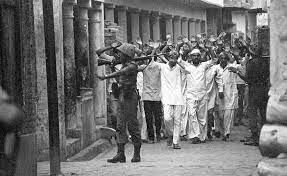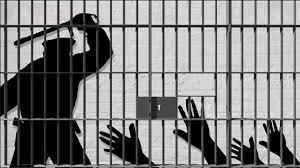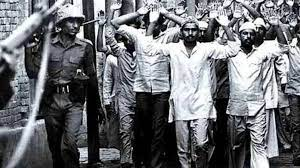
Hashimpura Massacre and Custodial Killings

Custodial death or torture is not a new concept to be discovered in India as it runs its roots of custodial death and torture deep into the history of the British period and we are still fighting to curb this social evil from society. To eradicate the existence of this social evil of custodial violence, the Indian government brought major changes to the legal system after attaining independence.
Custodial death is one of the worst forms of abuse that mostly happens when the police exercise their power and authority to limit excess using unnecessary force and finally end up taking the convict’s life due to their actions.
Custodial death may result from physical assault, rape, mental harassment, or torture that the police or the officer in charge of a police station does and takes a man’s life in police custody or magistrate custody.

Though torture has not been defined in the constitution or any other Indian law yet there are mentioned provisions in various sections of Indian law like section 76 of the Code of Criminal Procedure, sections 25 and 26 of the Indian Evidence Act, sections 330, 331 and 348 of Indian Penal Code, Section 29 of the Police Act were enacted to control the torture of the policemen over the accused though these are proved insufficient with passing time. No civilized law assumes custodial cruelty to exist and even after arrest the accused is entitled to protection and care and there must not be any sinister symptoms of violence during the accused’s custody.
Further, the National Human Rights Commission issued guidelines and general instructions in 1993 to all the states to follow and give intimation followed with post-mortem reports, magisterial inquest reports, videography reports, etc to the commission about the occurrence of custodial death within 24 hours.
Section 300 of the Indian Penal Code holds the public servant liable for culpable homicide amounting to murder if it exceeds its right and uses force and causes death. It also states that if any civil servant causes any injury to a convict while extorting his confession shall be liable for punishment.
The Hashimpura massacre crime dates back to May 1987 when India was inflamed by communal tempers by the dispute over the Babri Masjid in Ayodhya. The Rajiv Gandhi-led government ordered the opening of locks and allowed the Hindu prayers to enter into the medieval mosque which was also a disputed structure.
This act sparked violence as Muslims from different parts of the country started protesting in anger and in Meerut, a town on the outskirt of Delhi witnessed a fierce riot estimating the death of 350 people and the city was still smouldering for more than a month as was left by the slain of police bullets.
People were burnt alive, women were assaulted and an enormous number of houses, factories, shops, and vehicles were razed on fire and gutted in the violence leaving both the Hindu and Muslim community people of that area convulsed with sullen hate and anger.
The civil administrative body of the Uttar Pradesh government failed to quell the violence and pressed various bodies into services like 60 companies of the Provincial Armed Constabulary, 50 gazette police officers, the Central Reserve Police Force, and the Indian Army.
The Provincial Armed Constabulary which was already infamous for partisan apathy towards the Muslim community, barely had 2% Muslims in its rank to assist in controlling the communal riot. Senior police officer Vibhuti Narani Rai who was also the Superintendent police of the neighbouring district of Ghaziabad in his research report found that most of the police personnel completely overlooked the actions of the Hindutva organizations and held the Muslim community people as the mischief-makers of the violence happening and felt that because of Muslim intransigence, Meerut had become mini Pakistan and further believed that it would be an imperative step to teach the Muslim community ‘a lesson’.

On the warm night of May 22, 1987, amidst the orders of curfew and shoot-at-sight, the constables of the Provincial Armed Constabulary surrounded Hashimpura which was predominantly a Muslim residential area in the city of Meerut.
It was during the holy month of Ramadan when people were observing fast and the police forced the residents to step out of their homes as the residents cowered for hours on the road, the constables searched their homes and destroyed their furniture, goods, and food.
Further, the police arrested a number of men according to official records were 324, crowded them in the police trucks, and beat them with batons in the lockup. One of the survivors named Abdul Jabbar said that the police were commenting with statements like “This is sixer by Imran Khan”, “this is for the Hindu women you rape” etc while beating them.
Next, the injured people were shifted to jails where the prisoners attacked them leaving 5 dead. 50 men among the teenage and old remaining were rounded by the paramilitary constables into another yellow truck and while they were driven away their families and relatives wailed at them and also the men too pleaded for mercy to the constables to spare them but neither the men nor their families knew that would be the last time they were seeing them alive.
The men panicked as the truck drove towards the city’s outskirts and shouted with mourning dread but none were there to hear their cries. After sunset, the truck rumbled to a halt near the banks of the upper Ganga Canal in Muradnagar, Ghaziabad and then the constables took out the men one by one and shoot fire at them. Killing them, they would drag the dead bodies and throw them in the canal except for a teen named Zulfikar who was lucky enough to rescue as the bullet hit his shoulder and he acted to be dead to escape.
Comprehending the terrible truth of the happening, the men in the truck raised a great uproar and the constables panicked and changed their route after mounting the truck killed almost half of the men in an open fire and their bodies were dragged and thrown into the canal.
Still, luckily a man named Arif who was drenched in the blood of his companions managed to escape the manhunt while the remaining men kept recalling Allah and their loved ones. The constables completed the massacre of the remaining men at the Hindon Canal. Only 6 out of the 50 men picked up by the Provincial Armed Constabulary survived.
The dead bodies of the men were later found by the Superintendent of police of Ghaziabad, Vibhuti Narain Rai and he and the District Magistrate Zaidi reached the 41st Vahini to take the truck into custody for forensic examination and collect evidence for the massacre, the senior police Armed Constabulary officials refused to cooperate and assist them in doing so and the investigation was dragged for 7 long years.
In 1988, the Crime Branch Central Investigation investigated the massacre as per the direction of the state government but the report which was submitted in 1994 was never made public, and no charges were framed against the culprits. and insisted on filing complaints even after facing political oppression to suppress the story in fear of rebellion in the forces.

However, in 1995 the family members along with the survivors of the spine-chilling incident moved to the honourable Supreme Court seeking justice and to make those reports public and prosecute those who indicted it.
Refusing to intervene in the matter, the court asked the petitioners to approach the High Court and it remained unsolved not until 1966 when due to the extreme pressure, the government had to bow before the ones seeking justice, and finally, criminal charge sheets were filed against the 19 personnel of the 41st battalion of the Provincial Armed Constabulary who were involved in executing the massacre.
The CBI found more than 64 senior officials liable guilty of the filthy act though the state government claimed that since most of those found guilty were complicit in this crime, it is tough to say which senior official ordered the massacre particularly, and hardly anyone of them punished rather they flourished in their career.
The state government choose to indict those who pulled the trigger and not those who passed the order and even the low-ranked 19 police personnel who were found guilty were not arrested despite there being 23 nonbailable arrest warrants against them from 1997 to 2000.
Though in May 2015 the government of Uttar Pradesh announced Rs. 5 lakhs as compensation to the family of each victim, nevertheless, in September 2002 the case was transferred from the state of Uttar Pradesh to Delhi after an activist Iqbal Ansari along with the family members of the victims pleaded to the Supreme Court to grant so in the interest of justice.
After almost 19 years to the day of the massacre, in May 2016, charges were finally filed against the accused with the help and support of Rebecca John, a senior advocate and criminal lawyer, human rights lawyer Vrinda Grover and The National Human Rights Commission.
Though 3 of the accused died, the remaining 16 appeared for hearing in the Tis Hazari courtroom but they continued service and this scenario remained unchanged even though the government in Uttar Pradesh changed.
It is the verdict of the Delhi High Court that overturned the table as it held the judgment of the trial court of a clinching nature and considered the case to be a targeted killing of the minority community using state force and the convicted 16 personnel of the PAC was sentenced to life-long imprisonment.







